KUMEL Repository
1. Journal Papers (연구논문)
1. School of Medicine (의과대학)
Dept. of Family Medicine (가정의학)
유전성 질환및 감염성 질환의 진단을 위한 PCR의 적용
- Keimyung Author(s)
- Shin, Dong Hak; Bae, Ok Suk; Chun, Hyo Jin; Kim, Jae Ryong; Suh, Min Ho; Lee, Kyu Suk; Park, Woo Hyun
- Department
- Dept. of Family Medicine (가정의학)
Dept. of Surgery (외과학)
Dept. of Laboratory Medicine (진단검사의학)
Dept. of Microbiology (미생물학)
Dept. of Dermatology (피부과학)
- Journal Title
- 임상검사와 정도관리
- Issued Date
- 1994
- Volume
- 16
- Issue
- 1
- Keyword
- PCR; Tuberculosis; Leprosy; Hepatitis B; Hemophilia A
- Abstract
- Background : For evaluation of rapid and sensitive tools for diagnosis of tuberculosis, leprosy and HBV infection, and reliable tools for prenatal diagnosis and carrier detection of hemophilia A, we have performed polymerase chain reaction(PCR) amplifications using various clinical specimens.
Methods : PCR amplifications were used to detect tuberculosis, leprosy, hepatitis B and hemophilia A from various clinical specimens. In the PCR of tuberculosis, oligonucleotide pairs for M. tuberculosis IS6110 DNA were used as primers and M. tuberculosis H37Rv strain was used as a positive control, and amplified products of 123 bp fragments were detected. In the PCR of leprosy, oligonucleotide pairs specific for M. leprae DNA were used as primers and amplified products of 530 bp fragments were detected. In the PCR of hepatitis B, oligonucleotide pairs specific for HBV DNA(1763-1792 and 2032-2003) were used as primers and amplified products of 270 bp fragments were detected. In the PCR of Bel I-RFLP, oligonucleotide pairs for intron 18 in fator VIII gene were used as primers and after digestion of 142 bp amplified products with Bel I, two alleles i.e. negative allele(142 bp) and positive allele(99 and 43 bp) were identified.
Results : In the M. tubercuosis PCR, positive results were obtained in 16 of 20(80.0% ) sputums and seven of 10(70.0%) cerebrospinal fluids. In the M. leprae PCR, positive results were obtained in four of four(100%) biopsy specimens of Lepromatous leprosy(LL) and three of three(100%) biopsy specimens of Borderline lepromatous leprosy (BL). In the HBV PCR, positive results were obtained in 40 of 40 (100% ) HBs antigen positive sera, and four HBs antigen negative sera were all negative by PCR. In the PCR of Bel I RFLP within factor VIII’ gene frequency with negative allele and positive allele were 15.5% and 84.5% respectively, and female heterozygosity rate was 28.1% and heterozygosity rate of hemophilic carrier was 31.1%.
Conclusions : These results showed that the PCR provides very sensitive and effective tools for the accurate and rapid diagnosis of tuberculosis, leprosy, hepatitis B and hemophilia A.
임상적 및 방사선학적으로 결핵으로 의심되는 환자로부터 채취한 객담 및 뇌척수액에서 결핵균을 검출하기 위하여 bead-beating 방법으로 DNA를 분리하고,M. tuberculosis IS6110 DNA절편에 특이하게 결합하는 primer로서 PCR을 실시하여 다음과 같은 결과를 얻었다. 전기영동상 123bp의 중폭 산물은 음성대조로 사용한 pBR322 DNA와, B형간 염바이러스(HBV) cDNA, λ 박테리오파지 DNA 및 정상인 혈액 DNA 등에서는 관찰되지 않았으며, 5fg의 M. lubercubsis H37Rv DNA까지 검출 가능한 예민도를 보였다. 20예의 객담 중에는 16예(80.0%)가 결핵균 PCR검사 양성이었고, CSF 10예의 뇌척수액 중에는 7예(70.0%)가 양성이었다.
나병이 의심되는 환자로부터 채취한 피부 생검조직에서 나균을 검출하기 위하여 M. feprae DNA 절편에 특이하게 결합하는 primer로서 PCR을 실시하여 다음과 같은 결과를 얻었다. 전기영동상 530bp의 중폭산물은 음성대조로 사용한 M. tuberculosis DNA, λ 박테리오파지 DNA, 정상 혈액 DNA, 정상 피부조직,pBR322 DNA, herpes simplex virus (HSV) 감염된 섬유아세포 등에서는 관찰되지 않았으며,6.25×10-1개의 M. Zeprae까지 검출 가능한 예민도를 보였다. Lepromatous leprosy(LL) 4예 및 Borderline lepromatous leprosy (BL) 3예 등 7예의 나환자의 생검조직은 모두가 나균 PCR검사 양성 이었다.
B형간염이 의심되는 환자의 혈청에서 B형간염 바이러스 DNA를 검출하기 위하여 혈청을 0.2 M NaOH와 0.2 N HC1로 전처리하고 B형간염바이러스의 DNA염기서열 1763에서 1792사이의 sense primer와 2032에서 2003사이의 antisense primer로서 PCR을 실시하여 다음과 같은 결과를 얻었다. 전기영동상 270bp의 증폭산물은 음성대조로 사용한 수두-대상포진 바이러스(VZV), 엡스타인-바 바이러스(EBV), 인간 세포거대바이러스(HCMV), 단순 포진바이러스(HSV) DNA 둥에서는 관찰되지 않았으며,5fg의 HBV DNA까지 검출가능한 예민도를 보였다. 40예의 HBs Ag 양성환자의 혈청은 모두가 HBV PCR검사 양성이었으며, 4예의 정상인의 혈청은 모두가 HBV PCR검사 음성이었다.
A형 혈우병 31가계 구성원 104명(33명의 혈우 병환자를 포함한 남자 40명과 여자64명)을 대상으로 PCR에 의한 제8혈액응고인자 유전자의 intron 18영역의 Bcl I RFLP를 조사하여 다음과 같은 결과를 얻었다. 혈액응고인자 유전자의 Bcl I부위의 primer 8.1 및 8.2로서 PCR을 실시하고 Bell 제한효소로 처리한 다음 전기영동을 실시한 결과 절단점이 없는 142 bp의 대립인자(negative allele)와 99bp와 43bp로 절단된 대립인자(positive allele)를 관찰할 수 있었다. 두 대립인자의 발현 빈도를 보면, 104명의 피검자의 총 168개의 X-염색체중 Bcl I positive allele은 142개 (84.5%)였고 Bcl I negative allele은 26개(15.5%)였으며, 64명의 여자 중 18 명(28.1%)이 이형접합체임을 알 수 있었다. 따라서, 31예의 혈우병가계 중 10예(31.3%)에서 혈우병 보인자인 어머니가 차기 임신을 할 경우 혈우병 태아의 산전 진단이 가능할 것으로 사료되며, Bcl I RFLP의 다양성 정보제공율(PIC)은 0.26이었다.
- Alternative Title
- PCR Application for Diagnosis of Genetic and Infectious Diseases
- Publisher
- School of Medicine
- Citation
- 신동학 et al. (1994). 유전성 질환및 감염성 질환의 진단을 위한 PCR의 적용. 임상검사와 정도관리, 16(1), 193–206.
- Type
- Article
- ISSN
- 1225-097X
- Appears in Collections:
- 1. School of Medicine (의과대학) > Dept. of Dermatology (피부과학)
1. School of Medicine (의과대학) > Dept. of Family Medicine (가정의학)
1. School of Medicine (의과대학) > Dept. of Laboratory Medicine (진단검사의학)
1. School of Medicine (의과대학) > Dept. of Microbiology (미생물학)
1. School of Medicine (의과대학) > Dept. of Surgery (외과학)
- 파일 목록
-
-
Download
 oak-bbb-04910.pdf
기타 데이터 / 2.62 MB / Adobe PDF
oak-bbb-04910.pdf
기타 데이터 / 2.62 MB / Adobe PDF
-
Items in Repository are protected by copyright, with all rights reserved, unless otherwise indicated.